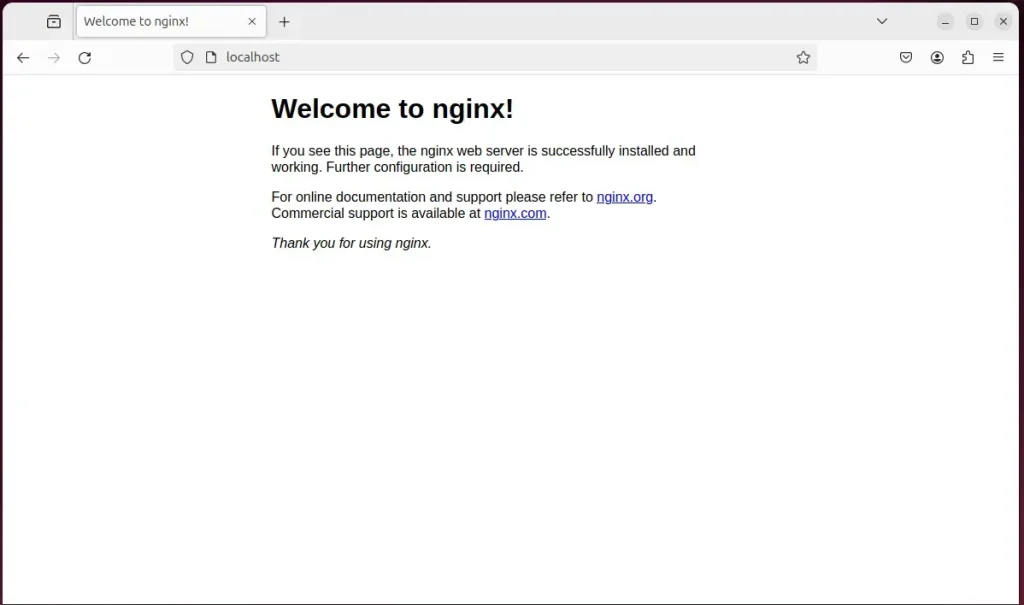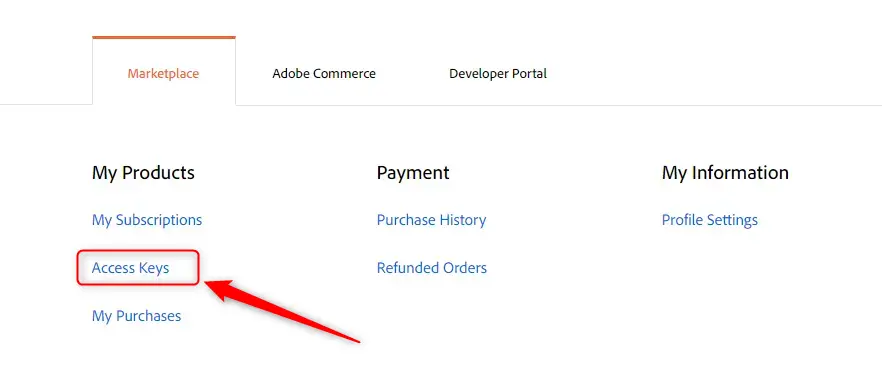This article explains how to install Magento with Nginx support on Ubuntu 24.04.
Installing Magento with Nginx support on Ubuntu can bring several improvements. Nginx, with its high performance, low memory usage, and ability to handle many concurrent connections, is an excellent choice for efficiently serving Magento’s dynamic content.
Using Nginx with Magento on Ubuntu can lead to faster response times, better resource utilization, and an enhanced user experience, sparking excitement about the potential improvements you can achieve.
The steps below will walk you through installing Magento with Nginx support on Ubuntu Linux.
Install Nginx HTTP server on Ubuntu Linux
Magento requires a web server. For this post, we will install and use the Nginx web server to run Magento.
To do that, open the Ubuntu terminal and run the commands below to install the Nginx web server.
sudo apt update
sudo apt install nginx
Once Nginx is installed, the commands below can start, stop, and enable the Nginx web server to start automatically when your server boots up.
sudo systemctl stop nginx
sudo systemctl start nginx
sudo systemctl enable nginx
You test that the Nginx web server is running by opening your web browser and browsing to the server’s localhost or IP address.
http://localhost

When you see the Welcome to nginx! page means the Nginx HTTP server has been successfully installed.
Additional help on installing Nginx on Ubuntu is in the link below.
How to install Nginx on Ubuntu
Install MariaDB database server on Ubuntu Linux
The next component that is required to run Magento is a database server. This post will install and use the MariaDB database server to run Magento.
To install and use the MariaDB database server, use the instructions below.
Open the Ubuntu terminal and run the commands below to install the MariaDB database server.
sudo apt update sudo apt install mariadb-server
Once the MariaDB database server is installed, use the commands below to stop, start, and enable the MariaDB server to start automatically when the server boots.
sudo systemctl stop mariadb sudo systemctl start mariadb sudo systemctl enable mariadb
Run the following commands to validate and test if the MariaDB database server is installed successfully.
sudo mariadb
Once you run the commands above, it will log you onto the MariaDB console and display a message similar to the one below.
Welcome to the MariaDB monitor. Commands end with ; or g. Your MariaDB connection id is 32 Server version: 10.11.2-MariaDB-1 Ubuntu 23.04 Copyright (c) 2000, 2018, Oracle, MariaDB Corporation Ab and others. Type 'help;' or 'h' for help. Type 'c' to clear the current input statement. MariaDB [(none)]>
The message tells you that the server is installed successfully.
Additional help on installing MariaDB.
Create a Magento database
Upon successfully installing the MariaDB database server, create a blank database specifically for the Magento application on the server.
It’s important to note that this database will be the repository for all the Magento application content and data, underscoring its significance in the setup process.
As part of the setup, we will create a database named ‘magentodb ‘and a corresponding user account named ‘magentodbuser ‘.
Finally, we’ll grant the magentodbuser full access to the magentodb database.
All the database steps above can be done using the commands below:
But first, log on to the MariaDB database server:
sudo mariadb
Then run the commands below to complete the steps:
CREATE DATABASE magentodb CHARACTER SET utf8mb4 COLLATE utf8mb4_general_ci;
CREATE USER magentodbuser@localhost IDENTIFIED BY 'type_your_password_here';
GRANT ALL ON magentodb.* TO magentodbuser@localhost WITH GRANT OPTION;
FLUSH PRIVILEGES;
exit
Ensure to replace ‘type_your_password_here‘ with your password.
Install PHP on Ubuntu Linux
The last component you will need to run Magento is PHP. The Magento application is PHP-based and supports the latest versions of PHP.
Run the commands below to install PHP.
sudo apt install php-fpm php-intl php-mysql php-curl php-cli php-zip php-gd php-common php-mbstring php-xmlrpc php-json php-sqlite3 php-zip php-soap php-bcmath php-xml
Additional help on installing PHP
How to install PHP on Ubuntu Linux
Download Magento files
We’re ready to download Magento and begin configuring it. You’ll need to install Composer, curl, and other dependencies.
Run the command below to install these packages and start installing Magento.
sudo apt install curl git curl -sS https://getcomposer.org/installer | sudo php -- --install-dir=/usr/local/bin --filename=composer
Before you can download Magento packages from its repository, you must create a new access key for Magento. The key is free.
To create authentication keys:
Log in to the Commerce Marketplace. If you don’t have an account, click Register. Click your account name in the top right of the page and select My Profile.
Click Access Keys in the Marketplace tab.

Click Create a New Access Key. Enter a specific name for the keys and click OK.
You can click to copy the new public and private keys associated with your account. Save this information or keep the page open when working on your project.
Use the Public key as your username and the Private key as your password.
With your Access key handy, please change it to the Nginx root directory. Then, run the command below to clone the Magento project and create a new site. Name the site “magento” or whatever you want to call it.
cd /var/www/
sudo composer create-project --repository=https://repo.magento.com/ magento/project-community-edition magento
Copy and paste the authentication key. (Your public key is your username; your private key is your password).
Enter the Username (your Access public key) and Password (your Access private key) from your marketplace account.
Output:
Authentication required (repo.magento.com):
Username: 234f2343435d190983j0ew8u3220
Password:
Do you want to store credentials for repo.magento.com in /opt/magento/.config/composer/auth.json ? [Yn] Y
After downloading Magento packages, run the commands below to install Magento with the following options:
cd /var/www/magento
sudo bin/magento setup:install --base-url-secure=https://magento.example.com/ --db-host=localhost --db-name=magentodb --db-user=magentodbuser --db-password=db_user_password_here --admin-firstname=Admin --admin-lastname=User --admin-email=[email protected] --admin-user=admin --admin-password=admin123 --language=en_US --currency=USD --timezone=America/Chicago
- The Magento software is installed in the root directory on localhost. Admin is admin; Your storefront URL is https://magento.examaple.com
- The database server is on the same localhost as the webserver.
- The database name is magentodb, and the magentodbuser and password are db_user_password_here.
- Uses server rewrites
- The Magento administrator has the following properties:
- First and last name are: Admin User
- Username is: admin
- and the password is admin123
- E-mail address is: [email protected]
- Default language is: (U.S. English)
- Default currency is: U.S. dollars
- Default time zone is: U.S. Central (America/Chicago)
During the installation, text will move quickly up the screen. When it is done, you will see a message similar to the one below.
[Progress: 1448 / 1448]
[SUCCESS]: Magento installation complete.
[SUCCESS]: Magento Admin URI: /admin_f97ul2i
Nothing to import.
If you encounter trouble installing Elasticsearch, read the article below to learn how to install It on Ubuntu.
How to install Elasticsearch on Ubuntu Linux
Ensure the Elasticsearch service is started.
After that, run the commands below to set the correct permissions, generate a crontab, and run Magento indexing.
Finally, clear the cache of your Magento installation.
sudo chown -R www-data:www-data /var/www/magento/
sudo -u www-data bin/magento cron:install
sudo -u www-data bin/magento cron:run --group index
sudo -u www-data bin/magento cache:clean
Configure Nginx for Magento
Once you have completed all the above steps, continue below to configure the Nginx web server to serve the Magento content.
Run the commands below to create a Nginx virtual host file for Magento.
sudo nano /etc/nginx/sites-available/magento.conf
Then, copy and paste the content block below into the Nginx server block.
upstream fastcgi_backend {
server unix:/var/run/php/php8.3-fpm.sock;
}
server {
listen 80;
listen [::]:80;
index index.php;
server_name magento.example.com www.magento.example.com;
set $MAGE_ROOT /var/www/magento;
access_log /var/log/nginx/example.com-access.log;
error_log /var/log/nginx/example.com-error.log;
include /var/www/magento/nginx.conf.sample;
}
Save the file.
Then, run the commands below to enable the server block and restart the Nginx server.
sudo ln -s /etc/nginx/sites-available/magento.conf /etc/nginx/sites-enabled/
sudo systemctl restart nginx.service
Setup Let’s Encrypt SSL/TLS for Magento
You may want to install an SSL/TLS certificate to secure your Magento site. Secure your Magento installation with HTTPS from Let’s Encrypt.
Please read the post below for additional resources on installing and creating Let’s Encrypt SSL certificates for Nginx.
How to set up Let’s Encrypt SSL certificate for Nginx on Ubuntu Linux
After installing, the Certbot Nginx plugin automatically configures the Nginx server block file /etc/nginx/sites-available/magento.conf with HTTPS.
Once you have restarted the Nginx web server, open your browser and browse to the server hostname or IP address defined in the Nginx server block.
https://magento.example.com
Magento default welcome page will appear.

That should do it!
Conclusion:
Conclusion:
- Installing Magento with Nginx support on Ubuntu 24.04 can significantly improve performance, resource utilization, and user experience.
- Integrating Nginx, MariaDB, and PHP creates a robust foundation for efficiently hosting a Magento application.
- The steps for setting up databases, creating a Magento database, installing PHP, downloading Magento files, and configuring Nginx are comprehensive and well-documented.
- The addition of Let’s Encrypt SSL/TLS provides an essential layer of security for the Magento installation.
- For any errors or additional information, the comments section is open for further discussion and support.

Leave a Reply